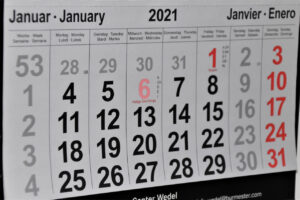Would you like to learn Swedish but don’t know where to start? Or are you going on holiday to Sweden and need some simple vocabulary and phrases? No problem, because the Swedish language is easier than you might think. In addition to basic vocabulary for beginners and travellers, you’ll find a brief introduction to Swedish grammar and pronunciation as well as further learning tips in our beginners’ course. You can also test yourself briefly after each lesson with our vocabulary trainer!
Swedish (svenska) is a Scandinavian or North Germanic language and belongs to the Indo-European language family. It is closely related to Danish and Norwegian, as all three are descended from Old Norse.
| Own designation | svenska |
|---|---|
| Language origin | Old Norse |
| Native speakers | approx. 8.5 million (of which approx. 290 thousand Finnish-Swedes) |
| Official language in | Sweden and in Finland (in addition to Finnish) |
| Dialects | 20 different dialects, divided into 6 large dialect areas |
Learn Swedish – Lesson 1: basic vocabulary and grammar
Basic vocabulary
| Hello! | Hej!/Hallå! |
| Welcome | Välkommen (Sg.) / Välkomna (Pl.) |
| Good morning/day/evening/night! | God morgon/dag/kväll/natt! |
| How are you? | Hur mår du? |
| I’m doing well. | Jag mår bra. |
| yes | ja |
| no | nej |
| Here you go! | Var så god! |
| Thank you! | Tack! |
| Excuse me? | Förlåt? |
| Excuse me, … | Ursäkta, .. |
| Bye! | Hej då! |
The pronouns
| I | jag |
| you | du |
| he | han |
| she | hon |
| it | den/det |
| we | vi |
| you | ni |
| they | de |
Since 2015, the Swedish language has officially had the gender-neutral pronoun hen. This is not only used by non-binary people, but can also be used when a person’s gender is not known or confirmed, for example in news programmes.
Introduce yourself
| What is your name? | Vad heter you? |
| My name is … | Jag heter … |
| Where are you from? | Var kommer du ifrån? |
| I come from Great Britain. | Jag kommer från Storbritannien. |
| I live in … | Jag bor i … |
| I was born in … | Jag föddes i … |
| I am … years old. | Jag är … år gammal. |
| I work as a … | Jag jobber som … |
| And you? | Och du? |
By the way: The informal form is not used in Swedish (the only exception is for members of the royal family). Just like in English, people are on first-name terms and the tone is relaxed.
Basic grammar rules: what you should know
- Capitalisation: Similar to English, everything in Swedish is written in lower case, except at the beginning of a sentence or when it is a name.
- Sentence position: Similar to German sentence formation, in Swedish the verb always comes second in the sentence. This also applies if the sentence does not begin with the subject, but with a time or place, for example. Then the order is: time/place verb subject.
- Gender and article: In Swedish, only two genders are distinguished, but these cannot usually be deduced from the grammatical gender (masculine/feminine) in other languages. In the singular, there are the two indefinite articles en and ett . If the definite form of a noun is to be formed, no other article is used, but the respective indefinite article (en/ett) is added to the noun as an ending (e.g. en banan -> bananen).
- Inflection of adjectives: Adjectives are divided into three groups depending on the noun to which they belong: en, ett or plural. The adjective is adapted to this with a respective ending (-t for ett /-a for plural). In the case of the en gender, it remains in its original form (with some exceptions).
- Conjugation and tenses: In Swedish, verbs are only inflected according to tenses, i.e. the conjugation of a particular verb is the same for all pronouns. A distinction is therefore made between the infinitive of a verb, the present tense, the past tense and the participle form. There are precise rules for tenses in Swedish, which you need to memorise.
Vocabulary trainer: Basic vocabulary




Learn Swedish – Lesson 2: how to find your way around on holiday
On holiday
| On holiday | på semester |
| Airport | (en) flygplats |
| Hand luggage | (ett) handbagage |
| Suitcase | (en) resväska |
| Rucksack | (en) ryggsäck |
| Cash machine | (en) bankomat |
| book | (att) boka |
| Passport | (ett) respass |
| Hotel | (ett) hotell |
| Reception | (en) reception |
| Floor / Etage | (en) våning |
| Room service | (en) rumbetjäning |
| Holiday home | (en) stuga |
| Old town centre (esp. Stockholm) | (en) gamla stan |
| Bicycle | (en) cykel |
| Train | (ett) tåg |
| Ticket | (en) biljett |
| Travel guide | (en) reseguidebok |
| City map | (en) stadskarta |
| Museum | (ett) museum |
| do something | (att) företa något |
| hike | (att) vandra |
| camp | (att) campa |
| swim | (att) simma |
Emergency
| Emergency | (ett) nödfall |
| Emergency call | (ett) nödrop |
| Help! | Hjälp! |
| Hospital | (ett) sjukhus |
| Pharmacy | (ett) apotek |
| Doctor | (en) läkare |
Swedish pronunciation: what you need to know
Swedish pronunciation is not difficult to learn. The intonation and some of the rules may take some getting used to at first, but this can be quickly overcome with regular practice.
How do you pronounce å?
The å, colloquially often called “a with a circle” or Bolle-å in Danish, is pronounced more like a soft o, or like the au in the English word “aunt”. The sounds are not quite the same: especially when the å is at the end, such as in the preposition på (on, at, in), it is more reminiscent of a mixture of o and a. However, most learners cannot tell the difference and it depends on the dialect, among other things.
Vocabulary trainer: On holiday



Order and shop
| order | (att) beställa |
| Restaurant | (en) restaurang |
| Café | (ett) café |
| I would like to have … | Jag skulle vilja ha … |
| Enjoy your meal! | Smaklig måltid! |
| Cheers! | Skål! |
| Breakfast | (en) frukost |
| Lunch | (en) lunch |
| Dinner | (en) middag |
| It tastes very good. | Det smakar väldigt bra. |
| Can I have the bill, please? | Kan jag få notan? |
| May I pay, please. | Kan jag få betala, tack! |
| That’s right. | Det är jämnt. |
| go shopping | gå och handla |
| Shop | (en) butik, (en) affär |
| Supermarket | (en) mataffär |
| Fruit and vegetables | frukt och grönsaker |
| Dairy products | mjölkprodukter |
| Meat | (ett) kött |
| Fish | (en) fisk |
| Bread | (ett) bröd |
| Water | (ett) vatten |
| Coffee | (en) kaffe |
| Beer | (ett) öl |
| Wine | (ett) vin |
| (Swedish) alcohol trade | Systembolaget |
| Clothing shop | (en) klädaffär |
| Cash register | (en) kassa |
| Bag | (en) påse |
| Where can I find … ? | Var hittar jag … ? |
| How much does it cost? | Vad kostar det? |
Orientation
| Orientation | (en) orientering |
| Entrance | (en) ingång |
| Exit | (en) utgang |
| Toilet | (en) toalett |
| Tourist information | (en) turistinformation |
| Railway station | (en) tågstation |
| Bus stop | (en) busshållplats |
| Post office | (en) post |
| Street | (en) gata |
| Petrol station | (en) bensinstation |
| Exit | (en) avfart |
| Car park | (en) parkeringsplats |
| Parking machine | (en) parkeringsautomat |
| Junction | (en) korsning |
| Motorway | (en) motorväg |
| Roundabout | (en) rondell |
| Bridge | (en) bro |
| Excuse me, I have a question. | Ursäkta, jag har en fråga. |
| Where can I find … ? | Var finns … ? |
| Where is … ? ? | Var ligger … ? |
| I am looking for … | Jag leter efter .. |
| How do I get there? | Hur kommer jag dit? |
| How far is it to … ? | Hur långt är det till … ? |
| I have lost my way. | Jag är vilse. |
| Turn round. | Vänd om. |
| You have to turn right/left. | Ta till höger/vänster. |
| Go straight ahead. | Går rakt fram. |
| behind | bakom |
| next to | bredvid |
| I would like a ticket from Stockholm to Malmö. | Jag skulle vilja ja ha en biljett från Stockholm till Malmö. |
Learn Swedish pronunciation: The most important rules for beginners
- The u is pronounced more like a German ü. It is similar to the å. Strictly speaking, the sound is not the same.
- One thing that immediately makes your pronunciation sound more Swedish is the correct r. It’s not easy, but here too, it’s worth practising! Try to roll your tongue backwards when pronouncing the r.
- The k is a tricky sound in Swedish. Depending on which letter follows it, it can make a different sound. For example, a k can be pronounced both like the c in car or somewhat like the ch in cherry. This is particularly the case before the words e, i, y and ä . An example of this is the famous Köttbullar.
- The g can also be pronounced in different ways. It can be pronounced like a g in “goose” or like a y. One example is the Swedish word for moose. Älg is pronounced more like Älj.
- The o can be pronounced both as o and u in Swedish. This is difficult because there is no simple rule. Both the short and the long o can be pronounced as a u. The only thing that helps here is to learn the pronunciation of the individual words directly. If you still make mistakes in this area, it’s not a problem. In most cases, you will still be understood.
Vocabulary trainer: On the road





Learn Swedish – Lesson 3: more everyday vocabulary
Weather
| Weather | (ett) väder |
| Weather forecast | (en) väderprognos |
| Temperature | (en) temperatur |
| Degree | (en) grad |
| Sun, sunny | (en) sol, solig |
| blue sky | (en) blå himmel |
| Rain, rainy | (e) regn, regning |
| Wind, windy | (en) vind, blåsig |
| Snow | (en) snö |
| Ice, icy | (ett) is, nedisad |
| Frost | (en) frost |
| Hail | (ett) hagel |
| Fog, misty | (en) dimma, dimmig |
| Clouds, overcast | (ett) moln, molnig |
| Storm | (en) storm |
| Thunderstorm | (ett) åskväder |
| Lightning | (en) blixt |
| Thunder | (en) åska |
| wet | våt |
| moist | fuktig |
| dry | torr |
| slick | slät |
| warm | varm |
| cold | kall |
| Season | (en) årstid |
| Spring | (en) vår |
| Summer | (en) sommar |
| Autumn | (en) höst |
| Winter | (en) vinter |
The Swedish language melody
The melody of Swedish takes a little getting used to. Many words are pronounced differently than you may be used to from English or other languages. This applies, for example, to the accentuation of vowels.
Whether a vowel is pronounced long or short makes a significant difference to the pronunciation of a word. As a rule of thumb in Swedish, you can remember that the end of a word tends to be emphasised. In addition, emphasised vowels are usually pronounced much longer than in English, for example.
The intonation of sentences is also often unfamiliar to learners of Swedish. Many books contain graphs that show where the characteristic “singsong” comes from. However, this is not so important for beginners. However, it is advisable to use a learning source that works with audio examples. Swedish radio can also help you get used to the melody later on. You can easily access this on the Sveriges Radio website, for example.
Numbers (up to 10)
| one | ett |
| two | två |
| three | tre |
| four | fyra |
| five | fem |
| six | sex |
| seven | sju |
| eight | åtta |
| nine | nio |
| ten | tio |
Days of the week
| Weekday | (en) veckodag |
| Monday | Måndag |
| Tuesday | Tisdag |
| Wednesday | Onsdag |
| Thursday | Torsdag |
| Friday | Fredag |
| Saturday | Lördag |
| Sunday | Söndag |
Learn Swedish pronunciation: 3 tips
- Learn pronunciation directly: In the long term, it is worth learning the pronunciation of words directly. This will make listening comprehension much easier later on. You should therefore try to use a learning source that provides you with audio recordings right from the start. Phonetic transcription is also an alternative.
- Repeat and record: If you have a source of audio recordings of vocabulary or sentences, then you should of course also try to repeat them. You should also think about making your own recordings, as this will allow you to identify your weak points and work on them.
- Listen to Swedish radio (or watch films and series ): Once you have reached a certain level in Swedish, Swedish radio or other spoken media such as podcasts and radio plays are a great way to get used to the melody of the language. It will also improve your listening comprehension. When you start out, you probably won’t understand much because native speakers speak much faster than what you’re probably used to. But don’t worry, this will improve over time.
Vocabulary trainer: weather, numbers, days




FAQ
It all depends on whether you have chosen the right learning method for you, are investing enough time and how much practice you already have in language learning. If you are used to learning and applying new grammar rules, it tends to be easier. But even if Swedish is the first foreign language you’re learning, you shouldn’t worry.
It also depends on which languages you already speak. If your mother tongue is English, you will notice many similarities, which will definitely make learning easier.
Due to their common origin, Swedish and Norwegian are very similar. One difference is that Norwegian does not have a standardised language. In writing, you have to choose between the variants Bokmål and Nynorsk. Although these are quite similar in many respects, this often means that several forms are correct.
There is no standard language in spoken Norwegian either. Every Norwegian speaks their own dialect. There is no “standard Norwegian”. So you will inevitably learn a certain dialect. That’s why people say that Swedish is a little easier to learn.
Although Swedish and Danish are also related, they are quite different in some aspects, especially when it comes to pronunciation. The pronunciation of Danish is perceived by many as somewhat more complicated, as it contains some sounds that Swedish does not have. However, this makes little difference to the difficulty of learning.
Learn Swedish in depth
Have you already internalised the basic vocabulary and want to learn Swedish intensively? Whether in a traditional language course or self-training with a suitable book, online or with an app: there are numerous options and methods from which you can choose the right one for you.
Books
If you want to learn Swedish completely independently and offline, learning materials are just the thing for you. Not all books are equally suitable for self-study beginners. That’s why we have a few recommendations here:
Audio books & audio language courses
If you are more of an auditory learner, you can of course also take an audio language course. Audible, for example, offers a selection here. The practical thing about this is that it’s easy to do on the go or on the side.



